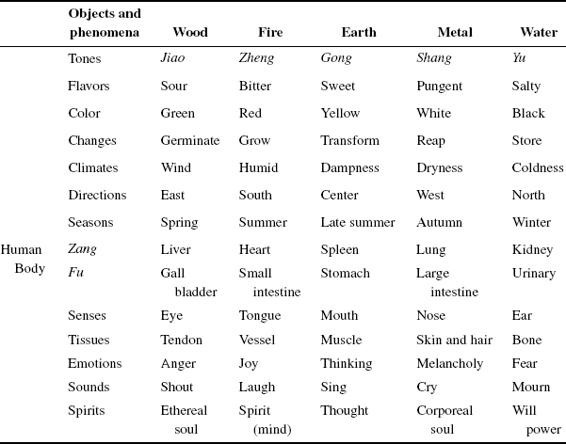The ancient Chinese categorized all physiological phenomena according to properties or actions symbolized by the Five Elements. The following examples correspond to Wood: Liver, because it promotes the spread of Qi and blood like a tree spreading out freely; Green, because it is the color of Wood’s (tree) leaves; Sour, because it is like green (immature) fruit; spring, because trees germinate then; and Wind, because it prevails in spring. Then, for example, because the Liver is categorized as Wood, so are the eyes, which reflect the Liver’s condition; the tendons, which are controlled by the Liver; and anger, which is apt to impair the Liver (seen in hot-tempered patients with Liver trouble)..
Fire flares up, and is characterized by heat and rising. Anything that is warm, hot, rising, or bright is classified as Fire. For example, the Heart propels blood to nourish and warm the body, so it is categorized as Fire.
Metal has the characteristic of malleability, or of being easy to transform. It is heavy, and is used to kill or cut. Descending and purifying activities are categorized as Metal. For instance, in performing the physiological functions of the Lung, Lung-Qi disperses and descends, so the Lung Zang (viscera) is categorized as Metal.
Water moistens and flows downward, so all things that moisten, descend, cool, or store are categorized as Water. For example, one of the Kidney’s physiological functions controls Water metabolism, so the Kidney Zang (viscera) is categorized as Water.
Earth holds and produces, so things that hold, process, and produce are categorized as Earth. For instance, the Spleen transports and transforms, producing nutrition and energy from food, so it is characterized as Earth.
Use the Five Elements categories to help determine properties. First, the image, properties, and functions of things are compared with the abstracted properties of the Five Elements. For example, according to the geography of China, the sun rises in the east, and the east is similar to Wood growing and spreading out freely in properties.

Things and phenomena in the same category are thought to have close relationships. A Sour taste, the color green, windy weather, the spring season and the body’s Liver, gall bladder, eyes, and tendons all correspond to Wood, and so should be closely related. The same applies to the other four categories. Therefore, the classification of things and phenomena provides a basis for the conformity of man with nature.
The Five Elements theory is subjective, especially to Western culture, such as the attributes shown but it may convey some deep meaning. For example, the five colors are the real colors corresponding to the aura’s color of the five Zang viscera. The aura is bio-light, which is invisible to normal people but can be visualized by some masters with extrasensory ability. The Basic Question of the Inner Canon of the Yellow Emperor points out, “… the Liver, taste is sour, color is green; … the Spleen, taste is sweet, color is yellow; … the Heart, taste is bitter, color is red; … the Lung, taste is pungent, color is white; … the Kidney, taste is salty, color is black”.
Quantum Mechanics is one of the major achievements of science and technology in the 20th century. Many new propositions established in quantum mechanics shocked the world As described by quantum equations, “the wave–particle essence” is expressed as a wave–particle function and substantiates that matter is both solid and invisible (or Yin–Yang and Qi). “Quantum entanglement” substantiates the complete holistic aspects of the system.
New propositions established by quantum mechanics harmonize with the ancient Oriental tradition and the Taoist philosophy, and answer many unexplained questions in TCM.

